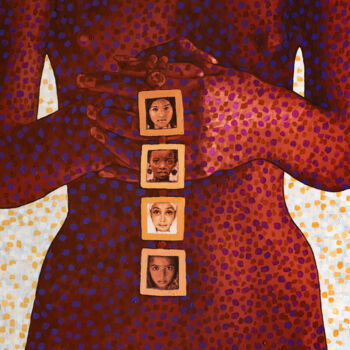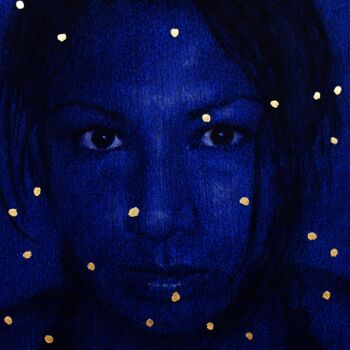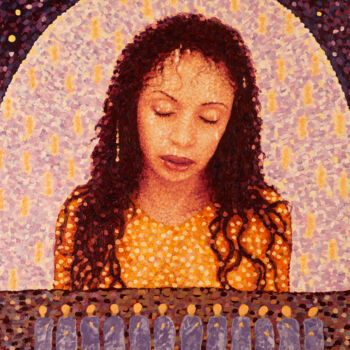Santa Margarita, Series: Saints and Virgins (2023) Painting by José Gislero
Seller José Gislero
-
Original Artwork (One Of A Kind)
Painting,
Oil
on Canvas
- Dimensions Height 17.3in, Width 13.4in
- Artwork's condition The artwork is in very good condition
- Framing This artwork is not framed
- Categories Conceptual Art Women Portraits
Su biografía fue escrita por su confesor, padre John Mush, completada en sus detalles con otros documentos contemporáneos. Margarita era hija de un candelero llamado Tomás Middleton y nació después de que Enrique VIII de Inglaterra hubiera separado la Iglesia de Inglaterra de la iglesia Católica de Roma. Su padre murió poco después y su esposa, luego de cinco meses, se casó con Enrique May, un homre de inferior condición, que estableció su residencia con la familia en la casa Middleton y Davygate.
En 1571, Margarita se casó con John Clitherow, un ganadero y carnicero que había sido encargado de puente y camarlengo con lo que llegó a merecer el derecho de usar el título de Sir antes de su nombre. Tenía 15 años, y tuvieron dos hijos.
Martyrdom
On March 10, 1586, John was summoned to appear before the court of York and his house was searched without anything suspicious being found until they found some children and others being instructed by a schoolmaster named Stapleton, whom they took for a priest. The teacher escapes through the secret room and the children were interrogated and threatened; a foreign boy of eleven, who lived with the family, became so terrified that he discovered the entrance to the priests' room. No one was occupying it, but in a cupboard were found glasses and books obviously used for the celebration of the mass which were confiscated. Margarita was apprehended and taken, first to the Council and then to prison in the castle.
Once reassured about the safety of her family, her courage never left her and when two days later she was reunited with Mrs. Anna Tesk, whom the same child had denounced for frequenting the sacraments, the two friends joked and laughed together. She even made all her brothers laugh by making a pair of pitchforks with her fingers and pleasantly laughed at them.
She refused to plead the cause to prevent her children from having to testify at the trial and many attempts were made to persuade her to apostatize. A Puritan, who had argued with her in prison, had the courage to stand up in court and declare that condemnation, based on the accusation of a child, was contrary to the law of God and man.
Judge Clinch sentenced her to death and rejoiced in the knowledge that she would be a martyr. She was put in prison in the house of John Trew, at Ouse Bridge; she was never allowed to see her children and only once was she allowed to meet her husband in the presence of the jailer.
The night before her martyrdom, she sewed her own shroud and then spent most of the time on her knees. At eight o'clock in the morning, the commissary came to take her to the dungeon, a few meters from the prison, and "everyone marveled to see her joyful and cheerful countenance".
On Good Friday 1586 she was taken to her execution where she knelt to pray aloud for the Pope, the cardinals, the clergy, the Christian princes, and especially for Queen Elizabeth that God would convert her to the faith and save her soul. Some of the Anglicans present there asked her to pray with them; but Margaret refused. She sent her husband her hat "in token of loving devotion, as the head of her family" and to Agnes, her twelve-year-old daughter, her shoes and stockings to signify that she should follow in her footsteps. Agnes became a nun in Louvain, while two of the martyr's sons later became priests.
She was forced to undress and lie face down on the ground on a pointed rock, her hands were tied to posts at her sides and a door was placed on her back, over which they loaded an immense weight of rocks and stones. Her last words, as she received the weight on her body, were, "Jesus, Jesus, have mercy on me!" Death came upon her in fifteen minutes and her body was left six hours in the press.
Related themes
José Gislero is a Swiss painter who focuses on sensual, spiritual art. He lives and works between two islands: Switzerland, the island in the middle of the European Union and Cuba the communist island in the Caribbean Sea.
José is convinced of the power of art to unite and harmonize the opposites of our world. Both are interdependent, both are firmly connected and interact.
He paints to create peace and balance.
His series of paintings are often like short stories or painted prayers. His style oscillates between figurative and expressionistic. His works blend both the material and spiritual world.
Although he has a degree in engineering and marketing, he has always been fascinated by art. His many long stays abroad awakened his special commitment and interest in third world issues. Peoples and cultures marginalized by 'civilization' and on the brink of extinction.
Born 1960 in Switzerland, where he has been brought up.
1985: BSc in Eng. / Cybernetics.
1986 – 1995: Engineering jobs mainly in Europe, Saudi Arabia, China, South-Africa and Peru.
1996: MBA, Changed over to Marketing.
1996 – 2008: Marketing jobs in Europe, Middle-East, Asia Pacific and the US.
2008: Decided to terminate his corporate life and moved to Havana (Cuba).
2008 – 2010: Escuela Nacional de Bellas Artes "San Alejandro", Havana (Cuba).
2010 – 2016: Working partly as artist, partly as artist craftsman, mainly on restoration of houses from the colonial period in Havana.
2017 onward: Working and living as an artist between Switzerland and Cuba.
José Gislero owns a studio gallery in Havana, where some of his paintings are exhibited.
-
Nationality:
SWITZERLAND

- Date of birth : 1960
- Artistic domains: Works by professional artists,
- Groups: Professional Artist Contemporary Swiss Artists















